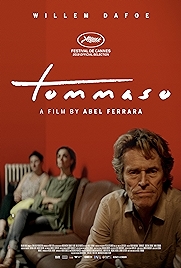Tommaso is a film by Abel Ferrara that’s essentially a film about Abel Ferrara, with Willem Dafoe in the lead role as an avatar of the writer/director, a creative dude trying to live out his golden years in Italy but finding old demons constantly resurfacing. It’s an uncomfortable and not entirely gripping drama, though Dafoe’s amazing performance does almost get it over the line.
We first meet the talented, accomplished and open Tommaso at a language school learning Italian, making the effort because he has a much younger wife at home (Ferrara’s own wife, Cristina Chiriac) and an infant daughter (Ferrara’s own daughter, Anna). He’s a film-maker, still working, and because of a successful streak he is now able to do things his way. He can enjoy life. Or he would if he wasn’t plagued by doubts, fears and a paralysing paranoia. And what does the much older husband of a hot wife fear?
Exactly. While out in the park with his daughter, Tommaso thinks he spots Nikki (Chiriac) in a clinch with exactly the sort of hot young dude you’d expect her to be hanging around with, rather than someone 30-plus years older than her. Tommaso has given up the drugs and the booze and is in good shape, but no amount of daily yoga in his apartment can bridge that gap.
To be fair to Ferrara, if this is an auto-biographical movie – and it looks like one – he’s unsparingly hard on himself, and he has absolutely no need to do that. He directed such crowd pleasers as Bad Lieutenant and The King of New York after all. After spotting the woman who might be his wife nuzzling up to AN Other, Tommaso is thrown into something between a funk and a fugue, adding to his general state of roiling self-doubt, which manifests itself as an extreme neediness and a relentless urge to hit on every woman he meets.
Working with just one rangey, dynamic camera, as he did so remarkably in Welcome to New York (which I’d recommend over this any day of the week) Ferrara shifts the film from realism to fantasy to nightmare. At night Tommaso dreams of being taken out and given a grilling in handcuffs, at one point later on he reaches under his shirt and pulls out his heart to show to some other guys sitting around a camp fire – look, the artist’s burden. Even later still, possibly as a semi-jokey reference to Dafoe’s time with Scorsese playing Jesus in The Last Temptation of Christ, Ferrara crucifies his main character, Dafoe suddenly bending down to look right into the camera in a “geddit?” sort of way.
Byronesque romanticism and arthouse humour in a film that’s a nightmare sundae, with all the various sprinkles and cream, chocolate and fruit replaced by phantoms and obsessions, delusions and misapprehensions, and whether you buy the whole self-centredness of the result – I did not – there’s something unique about it, and something absolutely brilliant about Dafoe, who swings between absolute naturalism and extreme mannerism, sometimes in the same scene. I’ve seen this described in one review as “winging it”. I’ll buy “winging it” too. Nothing can be quite pinned down in this movie.
Ferrara and Dafoe made that Pasolini film together in 2014 – Ferrara has lived in Italy since the 9/11 attacks – but here the dreaminess and otherworldliness of Antonioni also seems to be in the mix, alongside Ferrara’s usual hallucinatory, nightmarish confessions.
The suggestion that only half of what we are seeing might be real is bolstered by the simple echoey piano score (by Joe Delia, a regular Ferrara collaborator) and the regular displays of nudity also remove the film from the daily run of realistic drama. Tommaso is not your usual biopic about an artist, in other words. Ultimately, for all the misgivings, that’s a good thing.
Tommaso – Watch it/buy it at Amazon
I am an Amazon affiliate
© Steve Morrissey 2021


